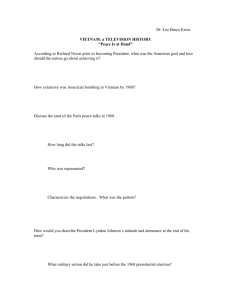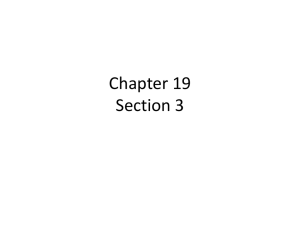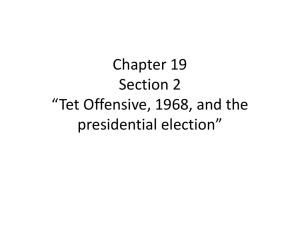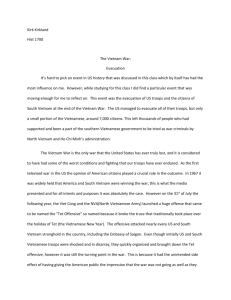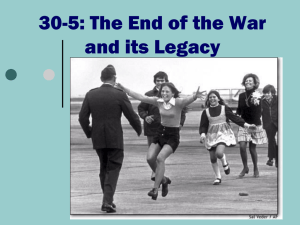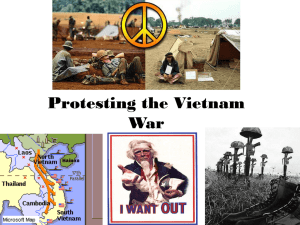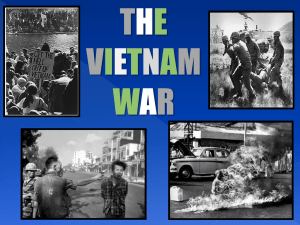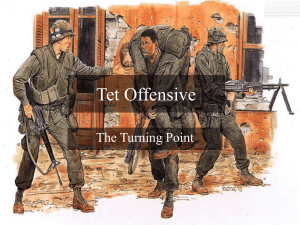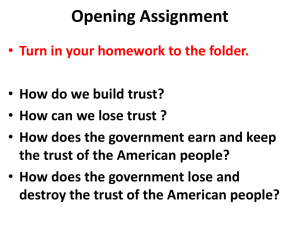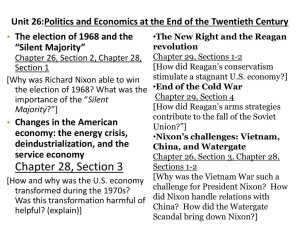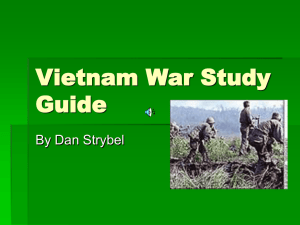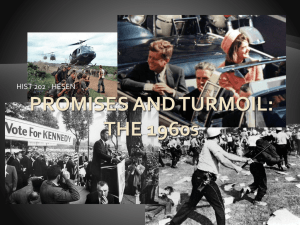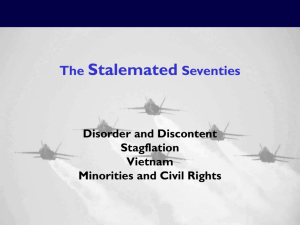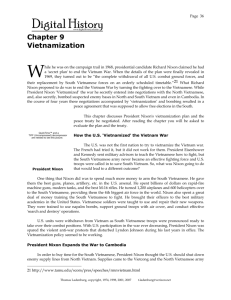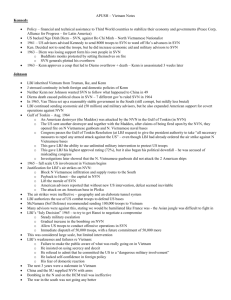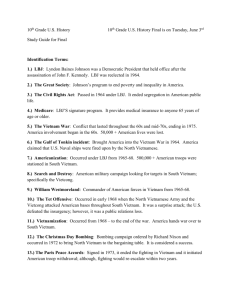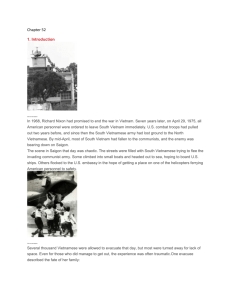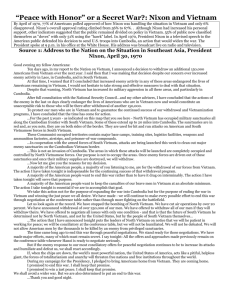Section 4: 1968 A Tumultuous Year
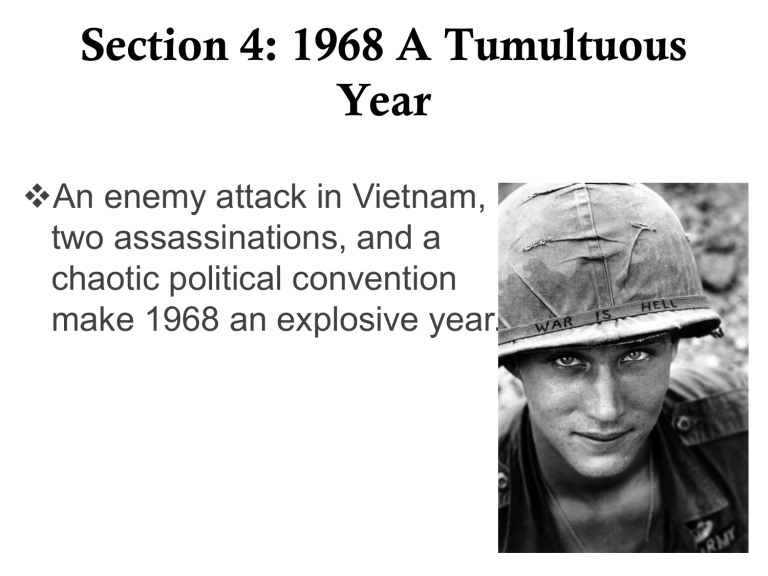
Section 4: 1968 A Tumultuous
Year
An enemy attack in Vietnam, two assassinations, and a chaotic political convention make 1968 an explosive year.
Tet Changes Public Opinion
•Before Tet, most Americans hawks; after Tet, hawks, doves both 40%
•Mainstream media now openly criticizes war
•LBJ appoints Clark Clifford as new Secretary of
Defense
•After studying situation, Clifford concludes war is unwinnable
•LBJ ’ s popularity drops; 60% now disapprove his handling of the war
Protest Songs…
• Crosby, Stills, Nash, and Young- Ohio
• http://www.youtube.com/watch?v=82CYNj7noic
Days of Loss and Rage
Johnson Withdraws
•Senator Robert Kennedy enters 1968 race after LBJ ’ s popularity plummets
•LBJ announces will seek peace talks and will not run for reelection
Violence and Protest Grip the Nation
•Riots erupt in over 100 cities after
Martin Luther King, Jr. is killed (April 4,
1968)
•Kennedy wins CA primary then is fatally shot by a man for supporting
Israel (June 5, 1968)
•Major demonstrations on over 100 college campuses
A Turbulent Race for President
Vice-president Hubert Humphrey wins Democratic nomination
Nixon Triumphs
• Nixon wins 1968 Republican nomination
• Campaign promises: restore law and order & end war in Vietnam
• Nixon wins presidency
Section 5- The End of the War and Its Legacy
President Nixon institutes his
Vietnamization policy, and America ’ s longest war finally comes to an end.
President Nixon and Vietnamization
The Pullout of Troops Begins
•New president Richard Nixon finds negotiations not progressing
•National Security Adviser Henry Kissinger works on new plan
• Vietnamization —gradual withdraw of U.S. troops from Vietnam, S. Vietnamese troops take over
“ Peace with Honor ”
• Nixon calls for “ peace with honor ” to maintain
U.S. dignity
• He still demands that South Vietnamese government remain intact and the North
Vietnamese stay out of S. Vietnam
• Despite this he secretly orders bombing of supply routes and bases in North Vietnam,
Cambodia, and Laos
Trouble continues on the Homefront
Mainstream America
•Nixon tries to appeal to the silent majority
• moderate, mainstream people who quietly support the war
But events divide the country…
The My Lai Massacre
•News breaks that U.S. platoon massacred civilians in My Lai village in S. Vietnam
•Lt. William Calley, Jr., in command, is convicted, imprisoned
The Invasion of Cambodia
• 1970, U.S. troops invade Cambodia to clear out Vietcong and North Vietnamese supply centers
• College students explode in protest
• 1.5 million protesting college students close down 1,200 campuses
Violence on Campus
• Kent State University
•May 4, 1970
•Massive student protest led to the burning of the
ROTC building
•Mayor calls in National Guard
•Protestors throw rocks at National Guard-
National Guard fires tear gas and live ammo into crowd
•9 wounded and 4 killed (2 were not even participating in the rally)
• http://www.cnn.com/video/#/video/us/2010/05/04
/costello.kent.state.cnn
The Pentagon Papers
Nixon invades Cambodia without even notifying
Congress
Congress repeals Tonkin Gulf Resolution
Support for the war decreases even more…
Pentagon Papers -show plans to enter war under LBJ before Gulf of Tonkin incident and that there was never a plan to end the war as long as the N. Vietnamese resisted
Confirm belief for many that the government was not honest about its intentions
http://www.history.com/videos/tet-offensivesurprises-americans#pentagon-papers-revealsecret-war
America’s Longest War Ends
“ Peace is at Hand ”
•1972 N. Vietnamese launch largest attack since Tet;
U.S. bombs cities, mines Haiphong harbor
•Kissinger agrees to the complete withdrawal of U.S.claims that “ Peace is at hand ”
The Final Push
•S. Vietnam rejects Kissinger plan to have North
Vietnamese troops stationed in South Vietnam
•Bombing resumes (“Christmas bombings”)
•Finally both sides call for end to war; peace signed
January 1973 (but N. Vietnamese troops would remain in
South Vietnam)
• On March 29, 1973 the last U.S. combat troops left
Vietnam
The Fall of Saigon
• Cease-fire b/n North and South collapses and fighting continues
• South surrenders after North invades in March of
1975
• Made into a unified Communist Vietnam
The evacuation of Saigon
The War Leaves a Painful Legacy
American Veterans Cope Back Home
• 58,000 Americans killed in war, over 300,000 wounded
• Over 2 million North and South Vietnamese killed
• Returning veterans face indifference, hostility at home.
• Many veterans adjust successfully but about 15% develop post-traumatic stress disorder.
Further Turmoil in Southeast Asia
• Communists put 400,000 S. Vietnamese in labor camps; 1.5 million flee.
• Civil war breaks out in Cambodia; Khmer
Rouge seizes power.
• Want to establish peasant society; kill at least
1 million people.
The Legacy of Vietnam
•1973- government abolishes military draft
•1973 Congress passes War Powers Act :
– President must inform Congress within 48 hours of deploying troops into hostile area
– 90 day maximum deployment without
Congressional approval
•Vietnam Veterans Memorial completed in 1982- Names listed in chronological order. Reflective stone used to bring the “past and the present together”
![vietnam[1].](http://s2.studylib.net/store/data/005329784_1-42b2e9fc4f7c73463c31fd4de82c4fa3-300x300.png)
